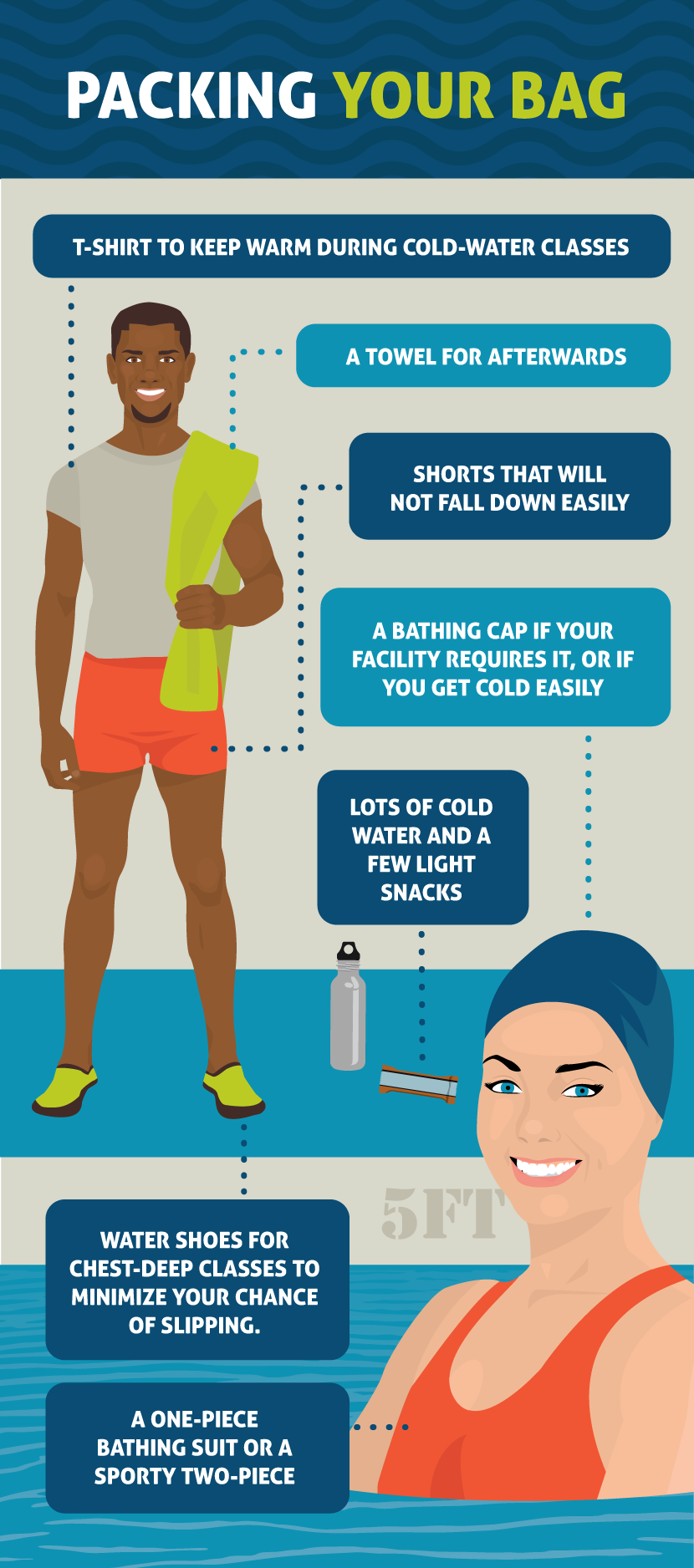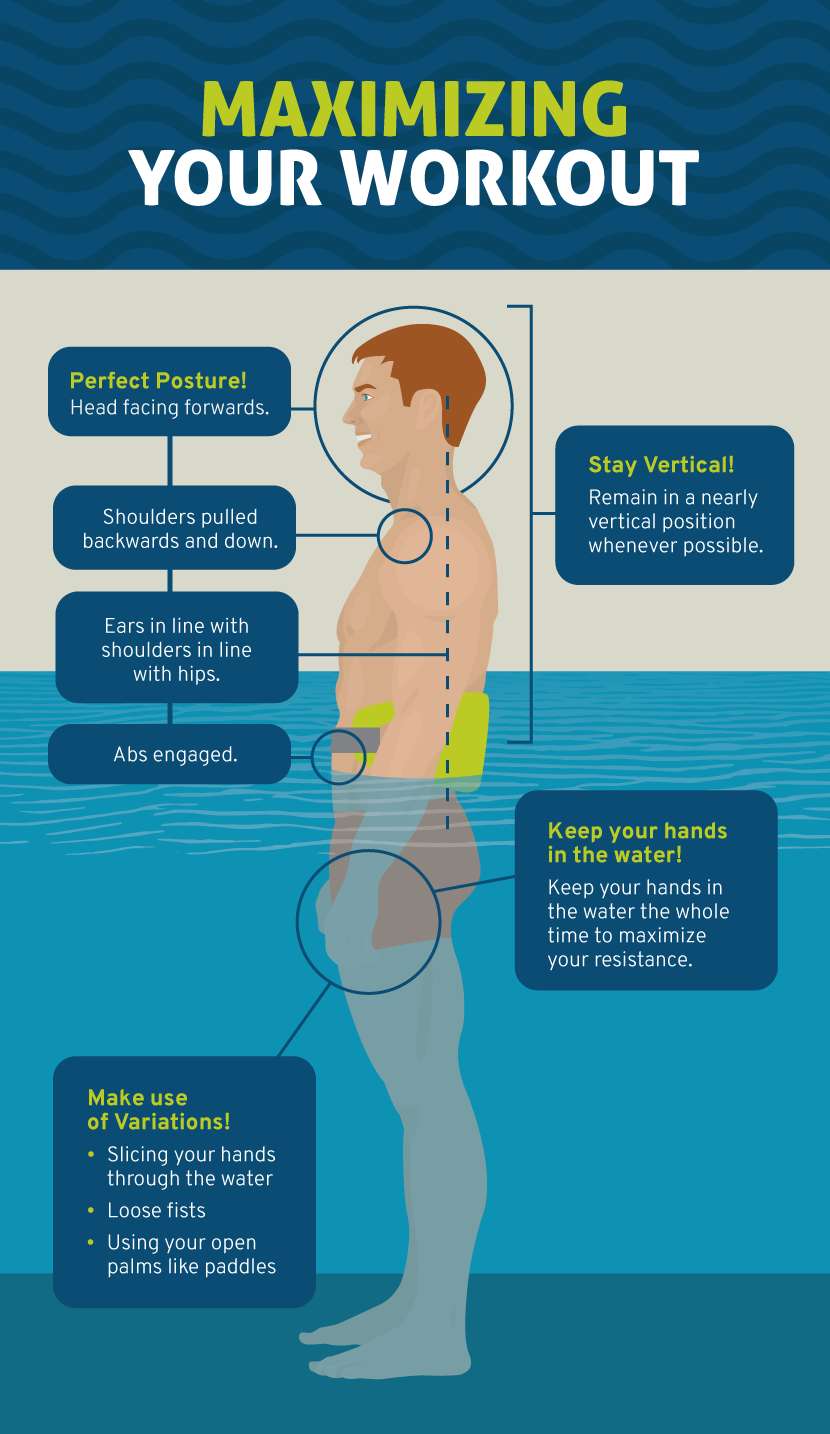From Exercise to Aquasize:
Choosing a Class That is Right For You
The history of aqua therapy dates to the fifth century, when bathing in thermal springs was considered not only hygienic, but also as having remedial effects.
It wasn’t until the 20th century that we began to see the use of water as an outlet for exercise.
Since then, the therapeutic and remedial properties of water-based exercises on cardiovascular and metabolic health have been and continue to be extensively studied.
Modern aquatic fitness classes take place in pools, and classes are designed with the intent of increasing your pulmonary and cardiovascular health without risking unnecessary joint and muscle pain.
Today, aqua fitness is a type of exercise that is performed in a vertical position, either in chest-deep water or while suspended in deep water with a foam flotation belt.
This type of exercise uses water as resistance, which allows the constant engagement of complementary muscle groups.
The waves created during a group aqua fitness class also add to the intensity of the workout by creating instability and turbulence, forcing participants to work harder to balance than they would have to on land.
Aqua fitness has extraordinary effects on your overall health.
Because of hydrostatic pressure (the varying amounts of pressure you feel at different depths of the pool)
a person’s heart and lungs are able to work between 30 percent and 60 percent harder than on land, while experiencing nearly the same amount of fatigue.
Who Does Aqua Fitness Benefit?
In short, aqua fitness has something to offer for everyone. In the water, most exercises are low- to moderate-impact and are suitable for a wide range of ability levels.
Programs like arthritis therapy and aqua yoga are of lower intensity than Aqua Zumba but are not necessarily limited to senior participants or people with arthritis.
Conversely, aqua jogging and general aquasize programs are not limited to higher-level athletes.
Even in high-intensity programs, a good instructor will offer modifications for moves in order to make the workouts less impactful on weak joints, and enjoyable for a broad range of participants.
If you are overweight, pregnant, or have painful joints, the sensation of buoyancy in the water creates a great sense of relief.
Every class has something unique to offer, and choosing the one that is right for you might take some time.
Ask if there are any “first time free” classes offered at your facility to help guide your decision.
Which Class is Right for You?
Before joining your first aqua fitness program, it’s important to identify exactly what you’re trying to gain from it.
Most aquatic facilities offer a diverse selection of classes to target the individual needs of their members.

Temperature Control
Because humans evolved to be endotherms – we generate energy and maintain our own body temperatures – and because water is a strong conductor of heat,
even the subtlest drop in temperature may make it feel like you are swimming in the Arctic Ocean. People who are unable to move vigorously,
have little body fat, or have little functional muscle mass are likely to become too cold during slow-moving/therapy-based exercises and may need to make some modifications.
If you feel your body temperature starting to drop during a workout, there are several things you can do to maintain comfort:
- Stay in one spot. As you move around in the water, your body heat will disperse. If you have the option to perform moves without leaving your spot, the water immediately surrounding your body will stay warm.
- Bundle up! As long as your facility allows it, feel free to wear a light T-shirt, tights, or bathing cap during your workout. A wetsuit, while seemingly effective, will be too buoyant for most aqua fitness classes, and will be difficult to remove quickly if you become overheated.
- Increase the intensity. If you are instructed to perform a move that isolates one part of your body, such as your pectorals, and feel your core temperature dropping, move your legs vigorously to preserve your body heat.
- Inrease the intensity even more. If you feel comfortable enough to increase the overall power of your moves, do it! You’ll generate much more body heat, as well as improve the overall effect of your workout.
- Stretch in the shower. Every class you attend should end in a five-minute guided stretch. If you find that you begin to shiver during this period, continue the routine in a warm shower.
On the other hand, higher-intensity workouts such as Aqua Zumba and aqua jogging are meant to be done in cooler temperatures,
but it’s difficult for any facility to meet everyone’s needs.
If you find yourself in an aquatic environment with only one pool and the temperature is too warm for the workout that you’re doing,
you might feel uncomfortable. Some suggestions for keeping cool are:
- Drink cold water. Bring a water bottle to every class that you attend – even the ones in cold water. Keep the water bottle on the edge of the pool deck - out of the way of the instructor – and hydrate, or pour it over your head, as necessary.
- Dunk. If you’re pressed for time or can’t afford to get your hair wet, try another suggestion for keeping cool. Alternately, if you’re planning on showering after the class, a quick submersion of your head works almost instantly to dissipate heat.
- Slow down. As moves get faster, your body will inevitably produce more heat. Assess which moves will help your reach your personal goals, and slow down the others.

Finding an Instructor that Works for You
It’s not uncommon for a facility to have only a few certified aqua fitness instructors.
If, however, you find yourself in a situation where you have the option of choosing an instructor,
there are a few key qualities to look for to ensure that you’ll be getting the most from your workout.
Simply put, look for the three Ps. Find someone who is punctual, personable, and prepared.
If the instructor arrives at least 15 minutes early to set up and to greet members as they arrive, don’t let him or her out of your sight.
Someone who arrives with a plan will benefit you more than a person who can wing it as the workout is in progress.
An instructor with a plan will have taken the time to come up with complementary moves, carefully thought-out intervals,
and differentiation strategies for any participant with specific needs.
If you’ve locked in the three Ps, the next thing to look for is someone who is certifiably knowledgeable about aquatic fitness.
You’ve chosen the right instructor if he or she takes the time to coach participants throughout the entire workout.
Find a class with an instructor who is not afraid to correct your posture or manipulate your arms when you’re doing something incorrectly;
there is nothing more detrimental to your workout – and, potentially, your health – than imprecisely performing a move.
Lastly, look for someone who exudes confidence and keeps you motivated.
A good instructor will tell you when you’re doing something right; a great instructor will be your cheerleader from start to finish.

The ways in which people use water has evolved greatly over the years, but its beneficial properties are undisputed.
Water offers resistance, buoyancy, and comfort, all of which come together to help create workouts that are specific to individuals’ needs.
Whether you choose to partake in an aquatic fitness program for rehabilitation, strength, cardio, or for the social aspect,
the water has something to offer everyone. Water is abundant in pools, lakes, and oceans; take advantage of it.
Embed the article on your site

